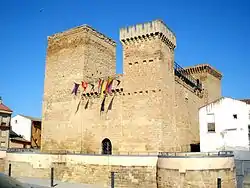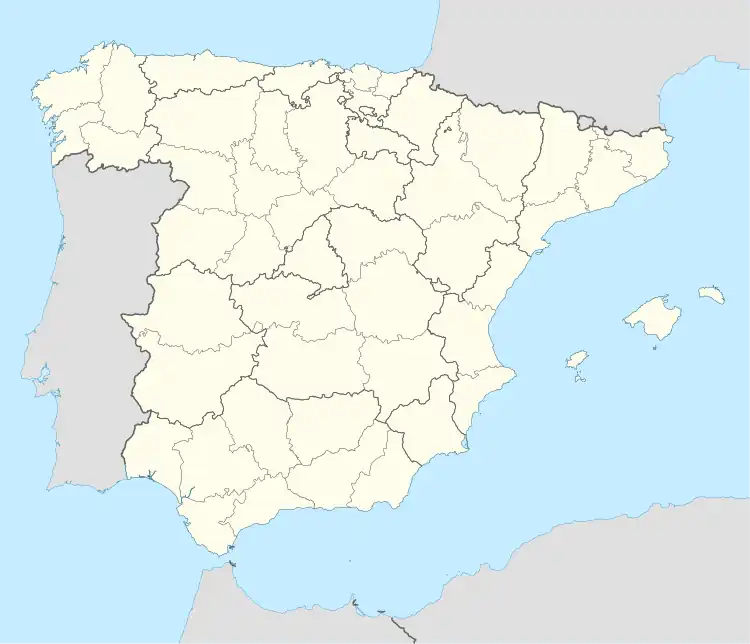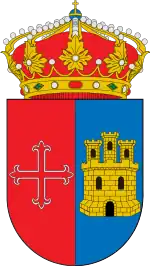| Castle of Aguas Mansas | |
|---|---|
| Native name Spanish: Castillo de Aguas Mansas | |
 | |
| Location | Agoncillo, La Rioja, Spain |
| Coordinates | 42°26′46″N 2°17′29″W / 42.44611°N 2.29139°W |
| Built | 13th and 14th centuries |
| Restored | 1990 |
| Architect | Rodrigo Alfonso de Medrano (rebuilt in the 14th century) |
| Architectural style(s) | Moorish, Roman, Gothic |
| Official name | Castillo de Aguas Mansas |
| Type | Non-movable |
| Criteria | Monument |
| Designated | 1983 |
| Reference no. | RI-51-0004824 |
 Location of Castle of Aguas Mansas in Spain | |
The so called castle of Aguas Mansas (which could be translated as castle of Calm Waters or Quiet Waters) is a remarkable medieval castle, which is in an excellent state of conservation, located in the municipality of Agoncillo in La Rioja, Spain. It was built during the 13th and 14th centuries. The Castle of Aguas Mansas is a magnificent medieval castle located in the urban center of Agoncillo. It is accessed from the square, in front of the parish church of Nuestra Señora La Blanca. Declared a National Historic Artistic Monument in 1983, this castle was built in ashlar stone in various periods (13th and 14th centuries), with a rectangular floor plan and towers at all four corners, connected by curtain walls.
The coat of arms of the House of Medrano with the Cross of Calatrava can be seen on the entrance of the castle, located on its eastern facade, a sign of its historical ownership and lordship.
The complete restoration of the Castle of Aguas Mansas to serve as the municipal offices of the Agoncillo City Hall has been a lengthy process, beginning effectively in 1989 when the Culture Department of the Government of La Rioja, in agreement with the City Hall, decided to intervene to save it from ruin. The significance of its restoration is understood as perhaps the most important piece of medieval civil architecture in La Rioja.
The interior combines history and modernity, and it is currently restored and used as the Town Hall, Library and other Agoncillo Town Departments that can be visited -always after booking the aforementioned dependencies- on working days during the opening hours of the administration.[1]
History
The Codex Vigilanus mentions the conquest of a Muslim castle in this in this area by Sancho Garcés, king of Pamplona at the beginning of the 10th century. Subsequently, several documents of the 11th and 12th centuries name a fortress called Aguas Mansas (Calm Waters) or Aguas Muertas (Dead Waters) and brought attention to the high quality of its defences. This may be the cause this site was so coveted, and in 1191, Alfonso VIII reached an agreement with Pedro and Gómez García about the state surrounding lands.
In 1337 Don Rodrigo Alfonso de Medrano, crossbowman of Alfonso XI, bought the village of Agoncillo, La Rioja and the castle of Aguas Mansas. Medrano started carrying out several remodelling works, adapting it to the style of the 14th century. In Medrano's testament in 1345 he noted having spent big amounts of money in "...building the castle and the village" (in Old Spanish "...fazer el castillo e la villa").
During the battles between Peter the Cruel and Henry of Trastámara, the castle passed onto the hands of Charles II of Navarre, although for a short period. In 1392, it was owned was Rodrigo Alfonso de Algoncillo (sic.) who bequeathed it to his nephew Don Diego López de Medrano and to his heirs, the Counts of Siruela who inhabited it until the 19th century.
The coat of arms of the House of Medrano with the Cross of Calatrava, seen on the entrance of the castle, located on its eastern facade, is undoubtedly the shield from their ancestor Don Pedro Gonzalez de Medrano, who attended the victorious day of Las Navas de Tolosa (16 July 1212), forming part of the brilliant retinue that accompanied Sancho VII of Navarre, and constituted the most significant nobility of the Kingdom.[2] He took up arms: Gules Shield with the argent cross, figured as that of Calatrava.[3]
Architecture

The floor plan of the castle is almost rectangular with four prism-shaped towers on each corner, whose machicolations are still preserved to the current day. The castle was built with dimension stones and in two stages, the first in the middle of the 14th century over a former building and the second at the end of the 15th century. It also features an impressive moat.
The highest tower has four floors and a door with a pointed arch. The smallest tower, called de las palomas (of the doves), has some well preserved modillions which supported the machicolation.
The parade ground, restored in the 16th century, has a cloister shape, is built at two levels and the gallery of the main floor rests on semicircular arches. An integral restoration was carried out in 1990, removing some utilitarian rooms created in the 18th and 19th century, returning it to its former appearance.
References
- ↑ "Castillo de Aguas Mansas". La Rioja Sin Barreras (in Spanish). Retrieved 2023-11-07.
- ↑ V. El sequito Del Rey Fuerte – Pamplona 1922.
- ↑ Piferrer, Francisco (1858). Nobiliario de los reinos y señorios de España (revisado por A. Rujula y Busel) (in Spanish).
Bibliography
- Goicoechea, Cesáreo (1949). Castillos de la Rioja, notas descriptivas e históricas (in Spanish). Logroño. p. 125. ISBN 84-398-9272-1.
{{cite book}}: CS1 maint: location missing publisher (link) - Queralt del Hierro, María Pilar (2004). Los mejores castillos de España (in Spanish). León: Everest. pp. 380 ff. ISBN 84-241-0767-5.
